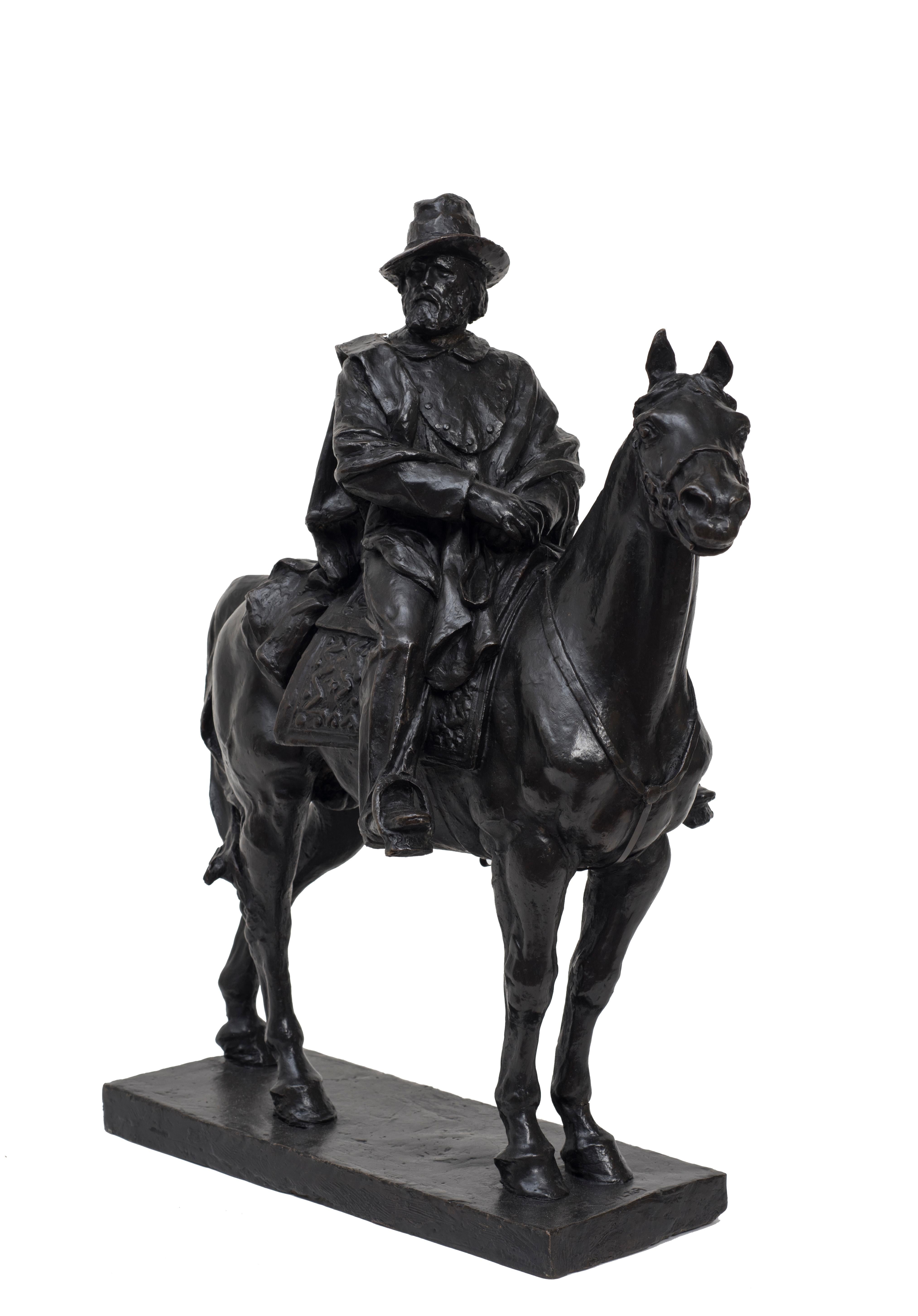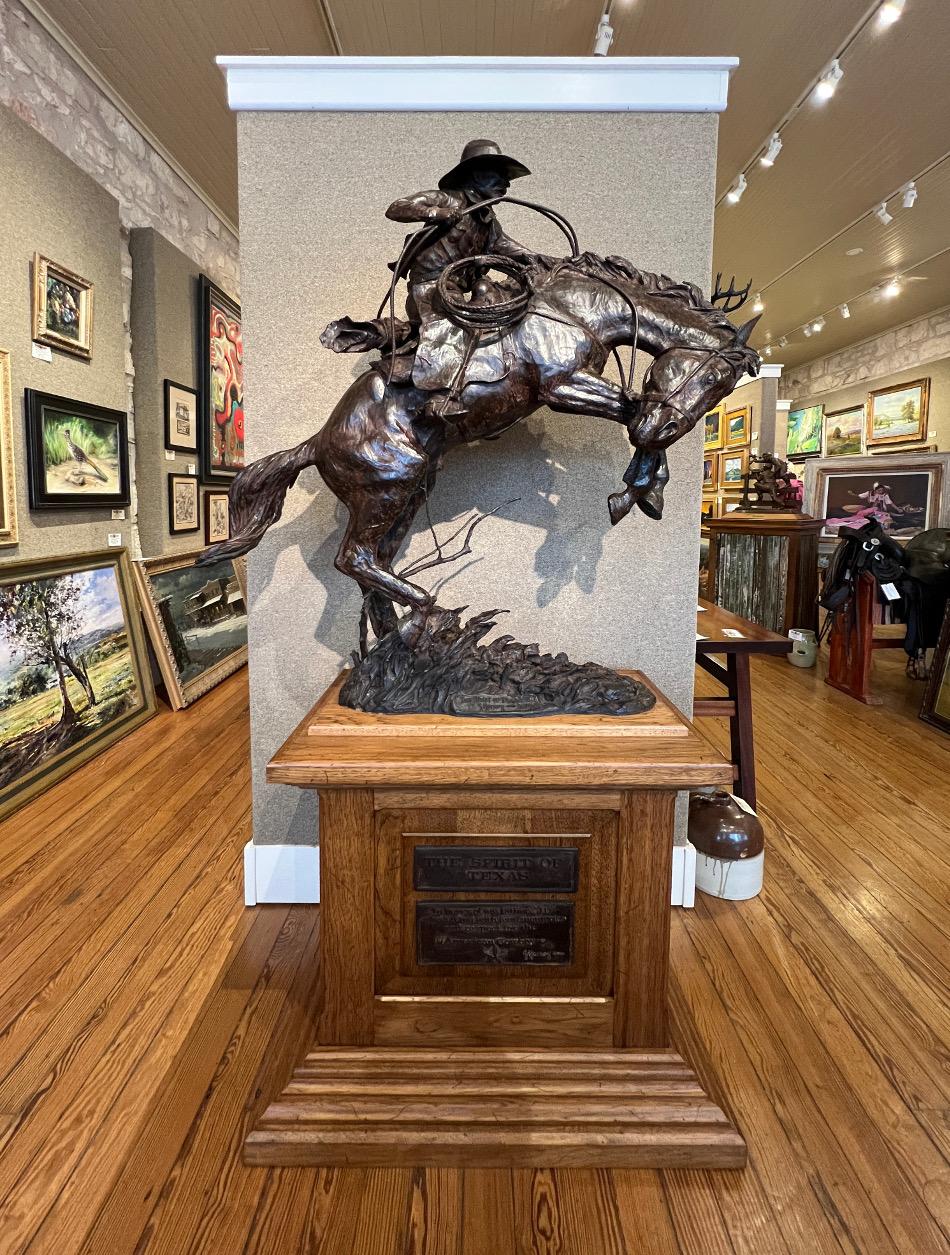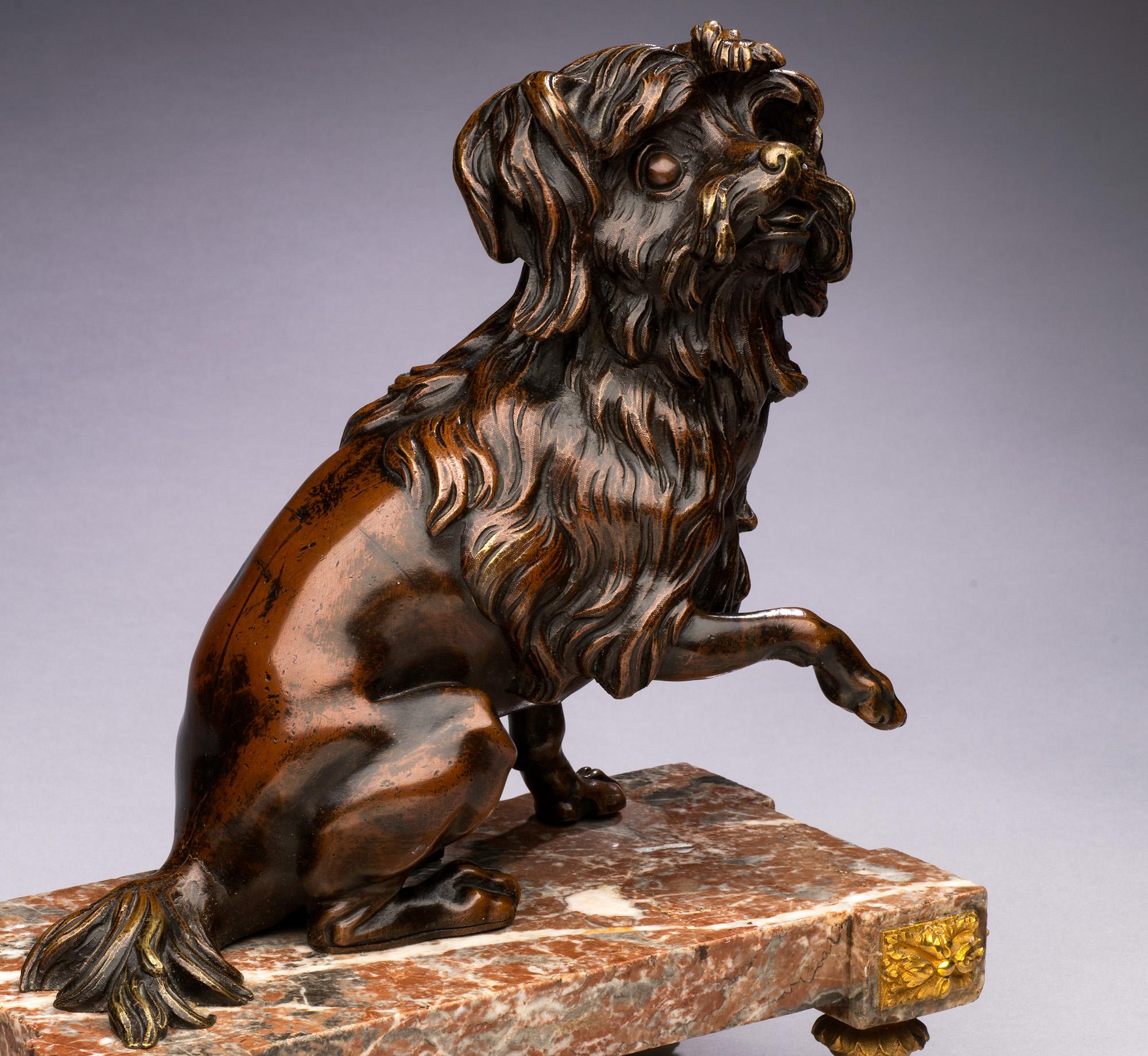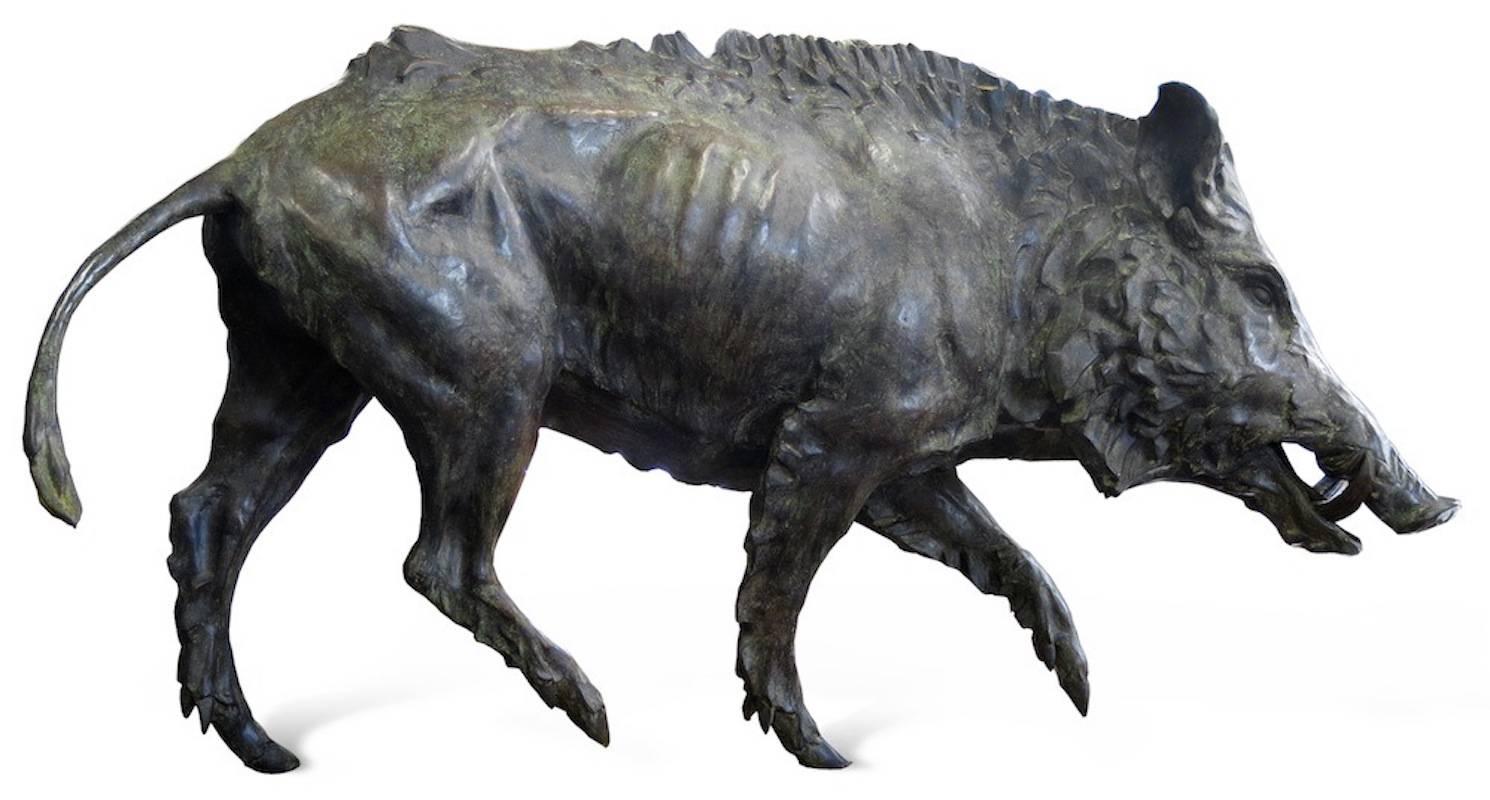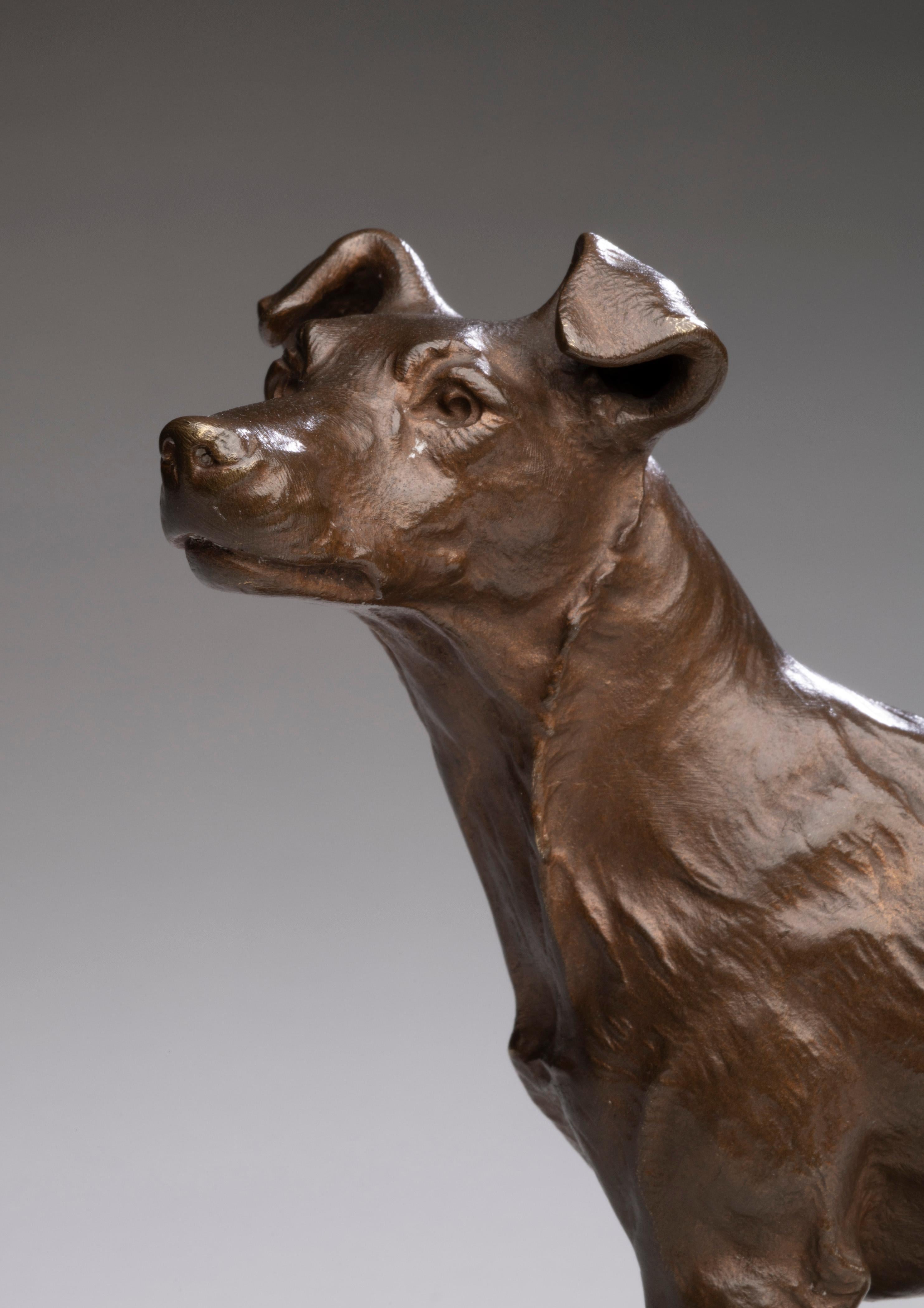Items Similar to 'The Fisher Boy', Large Bronze, Medal of Honor, Paris Universal Exposition, 1900
Want more images or videos?
Request additional images or videos from the seller
1 of 13
Comte Eugene D'Astanieres'The Fisher Boy', Large Bronze, Medal of Honor, Paris Universal Exposition, 1900
About the Item
A substantial lost wax bronze, cast after the original model by Eugène-Nicolas-Clément, Comte d''Astanière (French, 1841-1918). One of the larger-size castings in overall good condition and showing excellent patination. (N.B. Without fishing rod)
Eugene, the Comte d'Astaniere, was primarily known in his youth as a courageous and highly-decorated cavalry officer who distinguished himself repeatedly in combat, including against the Germans in the Franco-Prussian war of 1870, in which campaign he was severely wounded and almost died.
During his prolonged recuperation, he turned his attention to art and, in particular, to sculpting. He studied intensively with Jean Alexandre Joseph Falguière (1831-1900) , the preeminent French sculptor of the day who would become his life-long friend and artistic mentor. D'Astaniere quickly mastered the art of sculpture and was recognized by the Salon of 1882 with a Gold Medal for his first exhibited work.
From that time forward, he accumulated numerous diplomas, medals and juried awards for his work. At the Salon, he received frequent medals and was soon elected to membership of the Jury.
Count d'Astaniere exhibited 'The Juggler,' a large marble, at the Salon of 1887, then sent a bronze entitled 'Acrobat' to the Salon of 1889. At the Universal Exhibition in Paris in 1889, he received a bronze medal for the presentation of 'The Angler'. He exhibited in Moscow in 1891, at the 1893 Universal Exposition in Chicago receiving awards at both. He exhibited a marble entitled 'The White Monk' at the Salon of 1898 and obtained a medal of honor at the Universal Exhibition of 1900. As he continued to be celebrated for the military exploits of his youth, he was frequently commissioned to cast portrait sculptures of prominent members of fin-de-siecle Parisian military, political and artistic society.
We are pleased to offer this charming and informal example of the artist's work.
- Creator:Comte Eugene D'Astanieres (1841 - 1918)
- Dimensions:Height: 25 in (63.5 cm)Width: 8 in (20.32 cm)Depth: 7.5 in (19.05 cm)
- Medium:
- Period:
- Condition:good color and original patination; original fishing rod not present.
- Gallery Location:Santa Cruz, CA
- Reference Number:1stDibs: LU3445715462
About the Seller
5.0
Platinum Seller
These expertly vetted sellers are 1stDibs' most experienced sellers and are rated highest by our customers.
Established in 1982
1stDibs seller since 2013
639 sales on 1stDibs
Typical response time: <1 hour
- ShippingRetrieving quote...Ships From: Santa Cruz, CA
- Return PolicyA return for this item may be initiated within 3 days of delivery.
More From This SellerView All
- 'The Kiss', Two Young Lovers Embracing, French Lost Wax Bronze Figural GroupLocated in Santa Cruz, CASigned 'G. Flamand' for Georges Flamand (French, 1895-1925) and created circa 1920. Standing on a later striated, jade-green marble base. Base dimensions: 1.25 H x 4.25 D x 7.5 W Inc...Category
1920s Rococo Figurative Sculptures
MaterialsBronze
- Art Deco Carved Alabaster Figure of a HorseLocated in Santa Cruz, CAA substantial and dramatic Art Deco figure of a horse, hand-carved in rose-ochre alabaster. Unsigned, American School circa 1930.Category
1930s Art Deco Figurative Sculptures
MaterialsAlabaster
- 'Woman Standing', Modernist Sculpture, San Francisco Bay Area, de Young MuseumBy Wedo GeorgettiLocated in Santa Cruz, CAInscribed on base, 'W.G.' for Wedo Georgetti (American, 1911-2005) and created circa 1950. Acquired directly from the artist and accompanied by certificate of authenticity. Born in Italy, this California Post-Impressionist came to the United States at the age of one. Georgetti first worked as a merchant seaman to support his art studies and traveled all over the world accumulating sketches, many of which he later worked up into paintings. He made frequent visits to France, where he was influenced by the Post-Impressionists and, particularly, by the Nabis. An innovative theorist, Georgetti was the originator of the style known as California Fauvism. He exhibited widely and with success, both at exhibitions and at one-man shows (Oakland Art Gallery, 1942-44; Society of American Graphic Artists, NYC, 1944; Maxwell Galleries, 1940’s; de Young Museum...Category
1950s Modern Nude Sculptures
MaterialsWood
- 'Seated Nude', Woman Artist, Paris Salon, Jeu de Paume, World's Fair, GGIE LACMABy Caroline LloydLocated in Santa Cruz, CASigned 'Lloyd' for Caroline Lloyd (American, 1875-1945) and created circa 1935. Base impressed with foundry stamp, 'C. Valsuani Cire Perdue', for Claude Valsuani Fonderie, Paris. Please note: Video has not been color corrected; for correct color, refer to photographs. Born in Indiana, Caroline Lloyd first studied at the Convent of Notre Dame in Milwaukee. After raising a family, she moved to Paris where she studied under Robert Wierick at the Ecole des Arts Appliqué à l’Industrie and, subsequently, at the Académie de la Grande Chaumière in Montparnasse. In France, Lloyd quickly achieved both commercial and critical success and was made welcome in Modernist artistic circles. She exhibited widely, including at the Salon D'Automne, the Salon des Tuileries and the Salon des Beaux Arts among other Ateliers and galleries. At the Paris International Exposition of 1937, Lloyd was awarded a medal and her exhibited work was purchased by the French government for the permanent collection of the Jeu de Paume...Category
1930s Modern Nude Sculptures
MaterialsBronze
- 'Abstracted Figural Sculpture', Paris, Art Institute of Chicago, MichiganLocated in Santa Cruz, CASigned on base, 'Clyde Ball' (American, 1929-2017) and created 1975. Mounted on the artist's original granite base. (height, including base, 22 inches) Born in Indiana, Clyde Ball f...Category
1980s Modern Abstract Sculptures
MaterialsCopper
- 'Christ Pantocrator with Mary & St. John', Theotokos, Greek Orthodox, ChristianLocated in Santa Cruz, CAA very substantial, early 19th century, oil-on-canvas laid down on panel showing a view of the risen Christ Pantocrator flanked by the Virgin Mary and St....Category
Early 19th Century Byzantine Figurative Paintings
MaterialsGold Leaf
You May Also Like
- Show of InterestBy Brad RudeLocated in Denver, COArtist Brad Rude was born in Montana and has lived in Walla Walla, Washington most of his life. His journeys through his grandfather's folk art studio left...Category
2010s American Modern Figurative Sculptures
MaterialsEnamel, Bronze
- Garibaldi Riding a Horse - Original Bronze Sculpture by Carlo RivaltaBy Carlo RivaltaLocated in Roma, ITGaribaldi Riding A Horse is an original bronze sculpture realized by Carlo Rivalta. Signed by the artist. Beautiful and important sculpture representing the most famous Italian Hero...Category
Early 20th Century Figurative Sculptures
MaterialsBronze
- " THE SPIRIT OF TEXAS " HUGE, 81" TALL BRONZE BUCKING BRONCO COWBOY WESTERNBy G. HarveyLocated in San Antonio, TXG. Harvey (Gerald Harvey Jones) (1933-2017) San Antonio, Austin, and Fredericksburg Artist Image Size: 81 Inches Tall Medium: Bronze Sculpture Dated 2006 "The Spirit Of Texas" Bucking Bronco & Rider They are very scarce. I only know about 2 others that have even come up for sale in the last 10 years or so. Please not the dedication on the wooden base of the sculpture. There is one on Gerald Harvey Jones (G. Harvey) tombstone in the Texas State Cemetery in Austin, Texas. Western, Cowboy, Horse, Bronc, Bronco Riata, Rodeo G. Harvey (Gerald Harvey Jones) (1933-2017) Known for paintings closely linked in mood and subject matter to Edouard Cortes [1882-1962], G Harvey creates romanticized street scenes of turn of the century towns in America. Rain slick streets reflect urban lights, and the weather is obviously cold. He grew up in the rugged hills north of San Antonio, Texas from where herds of longhorn cattle were once driven up dusty trails to the Kansas railheads. His grandfather was a trail boss at 18 and helped create an American legend for his grandson. So the American West is not only the artist's inspiration but his birthright. Harvey's early interest in sketching and drawing slowly evolved into a passion for painting in oils. After graduating cum laude from North Texas State University, Harvey took a position with the University of Texas in Austin, but he soon realized that weekends and nights at the easel did not satisfy his love of painting. He abandoned the security of a full-time job in 1963 and threw his total energy into a fine art career. Harvey paints the spirit of America from its western hills and prairies to the commerce of its great cities. His original paintings and bronze sculptures are in the collections of major corporations, prestigious museums, the United States government, American presidents, governors, foreign leader and captains of industry. The Smithsonian Institution chose Harvey to paint The Smithsonian Dream, commemorating its 150th Anniversary. The Christmas Pageant of Peace commissioned Harvey to create a painting celebrating this national event. He has been the recipient of innumerable awards and the subject of three books. G. Harvey lived in Fredericksburg, Texas, with his wife Pat in a 150-year-old stone home built by German settlers. His studio and residence are nestled within the Historic District of Fredericksburg. It is obligation of fine artists to present us with more than pretty pictures. They must also make us feel. Among the western painters of today, there is none more capable of accomplishing this than G. Harvey. In his paintings, the viewer into only sees the physical elements of his subject, but also senses the mood that surrounds them. It is a remarkable aspect of fine art, which few artists are able to master. Gerald Harvey Jones was born in San Antonio, Texas, in 1933. His grandfather was a cowboy during the trail-driving era when legends grew up along the dusty trails north from Texas. Family stories of wild cattle and tough men were absorbed by a wide-eyed boy and became the genesis of G. Harvey's art. A graduate in fine arts at North Texas State University, Harvey taught full-time and painted nights and weekends for several years. It was through painting that he found his greatest satisfaction, and his native central Texas hill country provided the inspiration for most of his earliest work. With the development of his talent and the growth of his following, Harvey began to expand his artistic horizons. He left teaching and concentrated on a career in fine art. He sought the essence that is Texas and found it not only along the banks of the Guadalupe, but in cow camps west of the Pecos, and in the shadows of tall buildings in big Texas cities. The streets of Dallas once echoed with the sound of horse hooves and the jingle of spurs. Historic photographs reveal what it looked like, but only an artist like Harvey can enable a viewer to experience the mood and flavor or the time. Contemporary western art has too often centered on the literal representations from its roots in illustrations. Artists like G. Harvey take us a step further, to the subjective impressions that are unique to each great talent and which constitutes something special and basic to fine art expression. Harvey was a soft-spoken and unassuming man who cared deeply about what he painted without becoming maudlin or melodramatic. We sense there is more in each Harvey painting than just that which is confined to the canvas. Resources include: The American West: Legendary Artists of the Frontier, Dr. Rick Stewart, Hawthorne Publishing Company, 1986 Artist G. Harvey grew up in the rugged hills north of San Antonio, Texas from where herds of longhorn cattle were once driven up dusty trails to the Kansas railheads. His grandfather was a trail boss at 18 and helped create an American legend. The American West is not only the artist's inspiration but his birthright. Harvey's early interest in sketching and drawing slowly evolved into a passion for painting in oils. After graduation cum laude from North Texas State University, Harvey took a position with the University of Texas in Austin, but he soon realized that weekends and nights at the easel did not satisfy his love of painting. He abandoned the security of a full-time job in 1963 and threw his total energy into a fine art career. Two years as a struggling artist followed, but 1965 brought acclaim for the artist's first prestigious show, The Grand National exhibition in New York, and the American Artists' Professional League presented him with their New Master's Award. President Lyndon Johnson discovered his fellow Texan's talent, became a Harvey collector and introduced John Connally to the artist's work. Connally was enthusiastic about Harvey's art, and, on one occasion, he presented a G. Harvey original to each governor of Mexico's four northern states. Harvey paints the spirit of America from its western hills and prairies to the commerce of its great cities. His original paintings and bronze sculptures are in the collections of major corporations, prestigious museums, the United States government, American presidents, governors, foreign leader and captains of industry. The Smithsonian Institution chose Harvey to paint The Smithsonian Dream commemorating its 150th Anniversary. The Christmas Pageant of Peace commissioned Harvey to create a painting celebrating this national event. He has been the recipient of innumerable awards and the subject of three books. Through his art, our history lives. Gerald Harvey Jones, better known as G. Harvey, grew up in the Texas Hill Country listening to his father and grandfather tell stories about ranch life, frontier days in Texas, and driving cattle across the Red River. Early in his career, he began to draw inspiration from that collective memory for paintings that would eventually earn him the reputation as one of America's most recognized and successful artists. His art is rooted in the scenic beauty of the land he grew up in and the staunch independence of the people who live there. He says, "My paintings have never been literal representations. They are part first-hand experience, and part dreams generated by those early stories I heard. They are a product of every place I have been, everything I have ever seen and heard." G. Harvey graduated from North Texas State University. He taught in Austin, but continued to study art in his spare time, eventually devoting full time to his painting. The year 1965 was a turning point when he won the prestigious New Masters Award in the American Artist Professional League Grand National Exhibition in New York. It is often said that in viewing a work of art, one is granted a unique look into the thoughts and expressions of values that give meaning to the artist work. Nowhere does this ring truer than the art of G. Harvey. Though Harvey has had nearly two decades of sell-out shows, an outstanding honor came with a series of one-man shows in Washington, D.C. in 1991. The first was at the National Archives featuring his paintings of the Civil War era, then a selection of paintings of notable Washington landmarks was exhibited at the Treasury Department, culminating in a one-man show of 35 paintings at the Smithsonian Institution during their exhibition of The All-American Horse. His work was featured in Gilcrease Museum exhibitions from 1992-1997. In 1987 his alma matter...Category
Early 2000s Impressionist Figurative Sculptures
MaterialsBronze
- Antique 19th century Bronze Dog Portrait of a Maltese on a Marble BaseLocated in SANTA FE, NMAntique Bronze Dog Portrait of a Maltese on a Marble Base French 19th century 1/2 x 8 x 5 1/2 inches The chiseled bronze has a nuanced, rich brown patina depicting a Maltese in the round, seated on a quadrangular marble base decorated with very fine gilt bronze flowers and fluted feet. Napoleon III, Louis XVI style. Based on a model by Jacques Caffieri for the Prince de Condé in 1773. (More images to be added.) Executed during the nineteenth century, this figure is fully in line with the eclectic taste of the reign of Napoleon III. Indeed, the Empress Eugenie brought the Louis XVI style up to date in her castle of Compiègne. Jacques Caffieri is one of the most famous bronze smiths of the eighteenth century. In 1715 he was admitted as a master caster and chiseler, and worked almost exclusively for the crown castles...Category
19th Century Rococo Figurative Sculptures
MaterialsMarble, Bronze
- "Wild Boar" contemporary realist bronze cinghiale sculpture, life-size, FenskeBy Ben FenskeLocated in Sag Harbor, NY‘Wild Boar’, the striking new bronze sculpture by Ben Fenske and Richard Zinon, vibrantly illustrates the ‘new’ Renaissance currently under way. Ferocio...Category
21st Century and Contemporary American Realist Figurative Sculptures
MaterialsBronze
- Antique 19th cent. Dog Portrait Jack Russell Terrier by Pierre-Albert LaplancheLocated in SANTA FE, NMAntique Bronze Dog Portrait of a Terrier Pierre-Albert Laplanche (French, 1826-1873) Signed in script to base "Laplanche" Stamped "E.V 3753" 8 x 2.75 x 8 1/4 inches This is a super...Category
Mid-19th Century Academic Figurative Sculptures
MaterialsBronze
Recently Viewed
View AllMore Ways To Browse
Large Antique Bronze
Paris Exposition
Antique Medal
Antique Medalion
Antique Medals
Bronze Medal
Bronze Medalions
Medal And Bronze
Antique French Medals
Antique Gold Medal
Medal Exposition
Exposition 1900
Antique Bronze Medal
Original Antique Bronze Sculpture Art Sculptures
Parisian Antique Bronze
Youth Bronze
Boy Bronze Sculpture
Eugene Bronze
